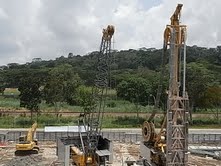Incidence of laid off workers hit new low in 2010
 Singapore's Manpower Ministry's (MOM) Redundancy and Re-employment report revealed that the number of workers laid off last year dropped to a new low - from 23,430 in 2009 to 9,800 in 2010. Singapore's Manpower Ministry's (MOM) Redundancy and Re-employment report revealed that the number of workers laid off last year dropped to a new low - from 23,430 in 2009 to 9,800 in 2010.
This means that 5.7 workers were made redundant for every 1,000 employees, less than half the 14 per 1,000 rate in 2009. The lowest ever recorded was 6 per 1,000 in 2007 (the redundancy data series started only in 1998).
Workers from the manufacturing sector remained the most vulnerable to lay-offs with 12 per 1,000 affected. Those in the construction sector ranked second with 5.4 per 1,000 affected while those in the service sector experienced a rate of 3.5 per 1,000. Vishnu Varathan - Asia economist at Capital Economics, explained that the main reason why the manufacturing sector remains the most vulnerable in Singapore is because of the ongoing upgrades of the manufacturing sector to produce higher value added products.
The MOM's Redundancy and Re-employment report shows there were 4,690 layoffs in manufacturing last year, down from 13,840 in 2009. The construction sector laid off 1,300 workers in 2010, slightly higher than the 950 in the previous year. Meanwhile, the services sector laid off 3,810 workers, a decline from 8,850 in 2009. Professionals, Managers, Executives and Technicians (PMETs) accounted for 35 per cent of the workers displaced, and 15 per cent were clerical, sales and service workers. Residents formed 58 per cent of the workers made redundant in 2010, down from 62 per cent in 2009.
Analysts said higher input costs and wage rises will continue to put pressure in the manufacturing sector. They added that employment opportunities would likely come from the services sectors, with the gaming and hospitality sector gaining traction.
Manufacturing Sector's biggest investments creates more good jobs for Singaporeans
Singapore's Prime Minister Lee Hsien Loong recently explained that through the controlled entry of foreign workers into Singapore has led to one of the largest investments in the country, and hence created more jobs for Singaporeans. Citing the example of a joint venture launch of IM Flash Singapore - between US tech giants Intel & Micron, being one of Singapore's biggest ever investment by global chipmakers at SGD $3.7 billion.
IM Flash Singapore employs 1,200 workers, of which six in 10 are Singaporeans and permanent residents, while four in 10 are foreigners. Mr Lee explained, "In the technician and manufacturing jobs, two-thirds are foreign workers, but in the managerial and professional positions, two-thirds are Singaporeans. So by putting Singaporeans and foreign workers together, we have put together a first class labour force, which has been able to meet the needs of demanding first class multinationals."
Based on strong market demands for smartphones and tablet PCs, analysts are forecasting the NAND Flash market revenue to grow to S$27 billion this year versus S$23 billion last year. NAND Flash memory chips is the cornerstone of IM Flash Singapore, which is gearing up for growing consumer demand as economic conditions improve globally.
Unemployment - Around the Region
Malaysia's unemployment decreased in February - data released by Malaysia's Department of Statistics. The jobless rate declined to 2.9 per cent in February from 3.4 per cent in January, with the number of jobless persons falling 15.7 per cent to 355,700.
Hong Kong's unemployment rate fell to a two-and-a-half year low of 3.4 per cent in the January-March period, its government reported. Hong Kong's jobless rate hit a peak of 5.5 per cent in the three months ending in August 2009, during the recent financial crisis, but it has since been declining steadily in tandem with the city's economic recovery.
Taiwan's unemployment rate fell in March to 4.48 per cent, according to Taiwan's Directorate General of Budget, Accounting and Statistics. Taiwan's March unemployment was lower than the 8.8 per cent in the U.S., 7.8 per cent in the U.K., 7.6 per cent in Germany and 4.6 per cent in Japan, but higher than South Korea's 4 per cent and Singapore's 2.2 per cent.
|

 Singapore's Manpower Ministry's (MOM) Redundancy and Re-employment report revealed that the number of workers laid off last year dropped to a new low - from 23,430 in 2009 to 9,800 in 2010.
Singapore's Manpower Ministry's (MOM) Redundancy and Re-employment report revealed that the number of workers laid off last year dropped to a new low - from 23,430 in 2009 to 9,800 in 2010. I mentioned before that a construction site was on-going near my house, giving me sleepless nights. Recently, the construction stopped work for a few days. But unfortunately, it started again, giving sleepless nights all over again. 24hrs a day, 7 days a week.
I mentioned before that a construction site was on-going near my house, giving me sleepless nights. Recently, the construction stopped work for a few days. But unfortunately, it started again, giving sleepless nights all over again. 24hrs a day, 7 days a week.

